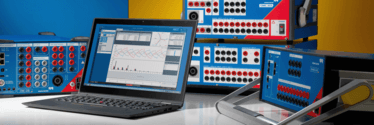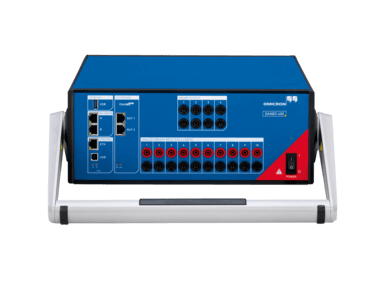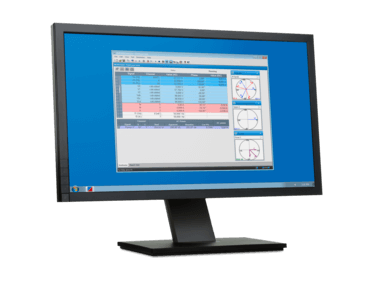
Measurement and Analysis in Protection, Automation, and Control Systems
Measurements and analysis in Protection, Automation, and Control Systems (PAC) are common tasks for power system engineers. For analysis, verification, fault detection, and troubleshooting, measuring many different signals or using sophisticated triggers to record sporadic events in the substation automation system is often necessary. The signals in electrical power systems are mainly voltages, currents, or binary states, but power measurement, harmonics, symmetrical components, etc., are also of interest.
Challenges of Measurement & Analysis in PAC systems
Ad-hoc measurment during testing
When conducting commissioning or maintenance testing in PAC systems, plausibility checks often need to be measured to analyze faults and protection behavior further. The availability of suitable equipment and a simple set-up are essential for efficiently performing these often-unplanned measurement and analysis tasks.
Hybrid measurement
The digitalization trend and its introduction to substation communication networks based on IEC 61850 applications presents new challenges for measuring and troubleshooting PAC systems such as these. Merging conventional power system signals with network messages is essential. Additionally, verifying network communication and its performance is a new and vital task that requires measurement tools capable of comprehensive analysis.
(Unattended) fault recording
Malfunctions or disturbances in a PAC system are often unpredictable. Faults occur infrequently and under conditions that are not always known, but when they do occur, it is critical to resolve such issues quickly. Creating recordings with sophisticated triggers for sporadic events is often required in such cases.
Distributed measurement
Due to the new capabilities of IEDs and new technology for wide-area communication, PAC systems functions are becoming more distributed. This factor has led to the need for distributed measurement solutions with multiple time-synchronized devices.
The Right Solution for Your Needs
Both can be used as recorders and analyzers for power measurement in generating, transmitting, and distributing power utilities. Either of them may be the appropriate solution depending on your application, e.g., protection testing, commissioning, SCADA testing, IEC 61850, power quality, and your components.
The table and sections below compare the capabilities of DANEO 400 with EnerLyzer.
| DANEO 400 | EnerLyzer on CMC | |
|---|---|---|
| Troubleshooting during testing | recommended | recommended |
| Measurement in digital and hybrid substations (IEC 61850) | recommended | supported |
| Distributed measurement with multiple time-synchronized devices | recommended | supported |
| Fault recording | recommended | supported |
Troubleshooting during testing
DANEO 400 and EnerLyzer give you various visualization options ranging from the multimeter, phasor, and time signal view over binary trace to bar graph (harmonic spectrum). Combined with the ability to measure voltages, currents, binary signals, sampled values, and GOOSE, they are the perfect troubleshooting equipment for the secondary system.
DANEO 400 is ideal if you are looking for a dedicated device that is lightweight, portable, flexible, and designed specifically for measurements and fault detection in PAC systems.
EnerLyzer is especially interesting for users of a CMC test set, as it allows you to turn it into a multifunctional device for measurement applications.
Measurement in digital and hybrid substations (IEC 61850)
DANEO 400 is a hybrid measurement solution and digital fault recorder that analyzes all conventional signals (voltages, currents, hard-wired binary status signals) and messages in the communication network in a substation. It is a complete solution for binary and analog signals, GOOSE messages, and sampled values according to IEC 61850, network traffic, and Precision Time Protocol (PTP) protocol analysis.
The classic version of EnerLyzer (available on CMC 256plus and CMC 356) focuses on recording conventional signals. However, GOOSE messages defined using the GOOSE Configuration module can be recorded and used as trigger. The EnerLyzer Live (available on CMC 430) can also be set up in the substation network to record Sampled Values signals according to IEC 61850-9-2 LE.
Distributed measurement with multiple time-synchronized devices
DANEO 400 is the best choice for setting up distributed systems to obtain time-aligned measurements with multiple time-synchronized devices. If the PTP communication protocol (according to IEEE 1588-2008) is available in the network, it can be used for accurate time synchronization. Alternatively, a dedicated PTP grandmaster clock can also be used.
EnerLyzer can be used for a distributed measurement with time-synchronized devices but requires an operator with a control PC at each measurement location.
Fault recording
DANEO 400 functions as a Digital Fault Recorder (DFR), monitoring signals and sporadic events while unattended in permanent or semi-permanent test setups. The device starts recording signals and network traffic, using predefined trigger conditions that allow autonomous recording and detect recurring disturbances. An internal memory is available for storing the event records, and an external hard disk can extend the disturbance recorder's storage capacity. Remote connection allows you to monitor the fault recorder's status and download recordings for analysis. The recordings can be exported in COMTRADE format.
EnerLyzer runs on a PC or notebook connected to the CMC test set. Therefore, it's best to use EnerLyzer for recordings triggered by events that can be initiated. Typical examples are recordings of transformer inrush, motor start-up, circuit breaker switching, and protection relay behavior analysis.
Find the right solution
Contact Us

